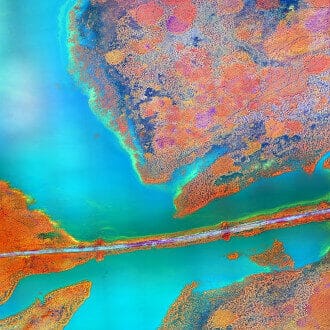By Sydney Cohen – According to the National Ocean and Atmospheric Administration (NOAA), “nutrient pollution is the process where too many nutrients, mainly nitrogen and phosphorus, are added to bodies of water and can act like fertilizer, causing excessive growth of algae.“
Eutrophication Process
Eutrophication, or a body of water’s excessive richness of nutrients, promotes harmful algal growth. Sources of nutrient pollution include surface runoff from agricultural production and pasture, chemical fertilizers, septic systems, sewage treatment plants, and combustion.
Waste from sewage is mainly responsible for eutrophication because it contains many nutrients, particularly excess nitrogen and phosphorus, in addition to harmful bacteria that harm our water quality. Releasing untreated water into large bodies of water can also be called wastewater dumping, which is an issue that takes place throughout the world.
Often, much nutrient pollution occurs in our coastal waters, as a result of urban nutrient runoff. According to the NOAA, “because there are increasingly more people living in coastal areas, there are more nutrients entering our coastal waters from wastewater treatment facilities, runoff from land in urban areas during rains, and from farming.” As mentioned, nutrient pollution most frequently comes from human activities and results in harmful algal blooms, which in turn, affect water quality, plant growth, and aquatic life, and can be harmful to human health.
What are the Effects of Nutrient Pollution?
Human activities contribute to eutrophication through the enrichment of nutrients in the water. It stimulates a wide variety of marine and terrestrial organisms, allowing algae to grow in places that it naturally would not. Nutrient pollution disturbs the natural balance in aquatic systems by damaging natural nutrient content. Excessive nutrients dramatically affect water networks and food webs in lakes, rivers, and coastal ecosystems. The system thus becomes dominated by phytoplankton, as phytoplankton communities feed on nutrients.
As one can concur, nutrient pollution has many harmful effects on our aquatic ecosystems. Continue reading to find out more about this environmental issue, and how we can work at reducing nutrient pollution. Typically, nutrients promote growth on land which can be incredibly beneficial to agricultural and farming industries. However, when these nutrients enter our water, they do not have the same advantages.
The basic concepts of nutrient-polluting can be easily explained. Nitrogen and phosphorous are naturally found in the soil and in our airways. They are mainly used as fertilizer by humans. Agricultural fertilization enhances growth on the land, and as we’ve seen with nutrient pollution, also in the oceans. At certain levels, nitrogen is causing algal population growth to take place more rapidly. As algae become degraded, they consume oxygen, which affects the vitality of other aquatic organisms such as fish, that rely on the oxygen in the water for survival.
Nutrient pollution, resulting from both nitrogen pollution and phosphorus pollution, has an incredibly harmful effect on aquatic ecosystems, and aquatic plants, as these organisms cannot get the oxygen needed for survival from the water. Nonpoint source pollution “generally results from land runoff, precipitation, atmospheric deposition, drainage, seepage or hydrologic modification” and, “unlike pollution from industrial and sewage treatment plants, comes from many diffuse sources.” Nonpoint source pollution makes reducing nutrient pollution very difficult, as the direct source of the nutrient pollution is nearly impossible to trace.
Nonpoint source pollution that contributes to nutrient pollution most commonly comes from “bacteria and nutrients from livestock, pet wastes and faulty septic systems.” As one can imagine, the higher amount of sewage treatment plants and septic systems, in addition to pets and agricultural and fertilizer runoff, are much more common and concentrated in urban areas. Because there is no one source of nutrient pollution that has been affecting our water quality and aquatic ecosystems, the persistent threat of nutrient runoff has been increasing nutrient pollution in our waters over decades.
Algal Blooms
According to the NOAA, “harmful algal blooms, or HABs, occur when colonies of algae — simple plants that live in the sea and freshwater — grow out of control and produce toxic or harmful effects on people, fish, shellfish, marine mammals and birds. The human illnesses caused by HABs, though rare, can be debilitating or even fatal.” Algal blooms are composed of phytoplankton communities and other aquatic organisms that feed on nutrients, creating dense clouds in the water.
The danger of harmful algal blooms is that “under the right conditions, algae may grow out of control — and a few of these “blooms” produce toxins that can kill fish, mammals and birds, and may cause human illness or even death in extreme cases. Other algae are nontoxic, but eat up all of the oxygen in the water as they decay, clog the gills of fish and invertebrates, or smother corals and submerged aquatic vegetation.”
The NOAA reports that “HABs occur naturally, but human activities that disturb ecosystems seem to play a role in their more frequent occurrence and intensity. Increased nutrient loadings and pollution, food web alterations, introduced species, water flow modifications and climate change all play a role.”
Excess nitrogen and phosphorus from agricultural production, atmospheric deposition, and burning fossil fuels are only some of the factors that contribute to the growth of algae. Enough algal growth can result in dead zones, where no aquatic organisms are able to survive since toxins and insufficient oxygen are a result of the algal blooms.
What are the Solutions for Nutrient Pollution?
Government, industries, and individuals should be urged to reduce nutrient pollution. Among the most effective strategies are the control of nutrient pollutants and the restoration of damaged ecosystems.
This is done by managing and reducing emissions into air and water. Switching to renewable and sustainable energy sources effectively reduces pollution from fossil fuels. Additionally, industries involved in water and sewage treatment should be mindful of any leakages allowing untreated water to enter our streams and rivers.
Study results indicate that controlling external nutrient sources does not always reduce the nutritive loads or the algal bloom. Lakes respond very slowly to nutritional control interventions.
Restoration of ecosystems involves recovering damaged waters. The biological properties in the water bodies are restored with this process. Fortunately, the Environmental Protection Agency is taking action to restore ecosystems that have been damaged by nutrient pollution.
The Environmental Protection Agency’s Great Lakes Restoration Initiative (GLRI), under the united states government, works “to strategically target the biggest threats to the Great Lakes ecosystem and to accelerate progress toward long term goals.” The focus areas include:
- Toxic Substances and Areas of Concern
- Invasive Species
- Nonpoint Source Pollution Impacts on Nearshore Health
- Habitats and Species
- Foundations for Future Restoration Actions
On April 14, 2020, in order to combat nutrient pollution, “the U.S. Environmental Protection Agency (EPA) announced fifteen Great Lakes Restoration Initiative (GLRI) grants totaling $9,056,711 to fund projects addressing excess nutrient runoff from nonpoint sources, including stormwater and agriculture, to the Great Lakes.”
EPA Administrator Andrew Wheeler stated that “the key to restoring the health of the Great Lakes in the coming years is to lower the amount of fertilizer and stormwater runoff entering the region’s waterways…these grants will help more farmers make the shift toward more no-till agricultural methods that, when properly practiced, result in less top-soil erosion and better water quality.” These efforts by the EPA will hopefully reduce nutrient runoff, particularly that is coming from agricultural industries and urban areas. Government efforts are primarily geared towards controlling the flow of nutrient pollution from nonpoint sources. While this proves to be difficult work, as the EPA’s plan indicates, financially helping farmers switch to less environmentally harmful methods will help reduce the flow of nutrient pollution into our waterways.
How You Can Take Action!
There are a few ways to reduce your personal contribution to nutrient pollution. To start, it is important to fertilize responsibly, and it is best to “use a product with slow-release nitrogen, or try amending your soil with compost.”
You should also be sure to get your septic system inspected annually to make sure there are no leaks. You can also plant trees and other native plants, as “plants help reduce runoff by soaking up stormwater along with the nitrogen that often comes along with it.” Let’s all work together to prevent nutrient pollution from taking a further toll on our environment!
Nutrient Pollution and Religion
An Indian Study from 2021 studied The Effect of Religious Dietary Cultures on Food Nitrogen and Phosphorus Footprints. This study looked at different religious groups in India and how their different dietary practices (e.g. vegetarian, omnivore, etc) related to their Nitrogen (N) and Phosphorus (P) footprint.
As described in another study, the Indian study “suggests that a shift from a diet based on animal protein to a plant-based diet would significantly decrease individual P footprints at the Indian national level.” In other words, our individual choices can have a big impact on our contribution to nutrient pollution. Through our personal practice and educating our coreligionists, we can shift our diet to be healthier and more sustainable.
* Featured image source







